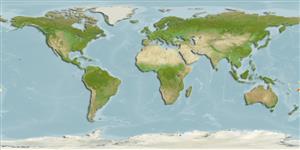>
Acanthuriformes (Surgeonfishes) >
Pomacanthidae (Angelfishes)
Etymology: Centropyge: Greek, kentron = sting + Greek, pyge = tail (Ref. 45335); deborae: The authors took the recommendation of Walt Smith, who collected the type series and provided the underwater photograph and detailed collecting data of the new species for this study, to name the fish after his wife, Deborah Smith. Deborah is an Israelitic name that does not exist in Latin. The genitive form of the non latin feminine word is deborahae. For reasons of euphony, however, the deborae was finally adapted. The new common English name of this species should be the blue velvet angelfish (Ref. 89471).
Environment: milieu / climate zone / depth range / distribution range
Écologie
marin récifal; profondeur 5 - 25 m (Ref. 89471). Tropical
South Pacific Ocean: Fiji Is.
Taille / Poids / Âge
Maturity: Lm ? range ? - ? cm
Max length : 7.0 cm SL mâle / non sexé; (Ref. 89471)
Description synthétique
Clés d'identification | Morphologie | Morphométrie
Épines dorsales (Total) : 13 - 14; Rayons mous dorsaux (Total) : 16 - 17; Rayons mous anaux: 17 - 18. Dorsal-fin spines XIII or XIV (usually XIV); dorsal-fin rays 16 or 17 (usually 16); anal-fin rays 17 or 18 (usually 17); pectoral-fin rays 15 or 16 (usually 16); scales large, about 43 or 44 in longitudinal series; gill rakers 5 or 6 + 12 or 13; supraneural bone 1; body depth 1.7-1.8 in SL; head length 3.2-3.5 in SL; last dorsal spine longest, 1.2-1.4 in HL; preopercular spine (10.0%-12.8% SL), slightly longer than eye diameter; relatively deep cheek depth (13.6%-5.5% SL); color when alive bluish-black with whitish posterior caudal-fin margin, pectoral fin rays black, and fin membrane transparent; color in alcohol uniformly black with a transparent posterior caudal-fin margin (Ref. 89471).
Life cycle and mating behavior
Maturities | Reproduction | Spawnings | Egg(s) | Fecundities | Larves
Shen, K.N., H.C. Ho and C.W. Chang, 2012. The blue velvet angelfish, Centropyge deborae, a new pomacanthid from the Fiji Islands, based on genetic and morphological analyses. Zool. Stud. 51(3):415-423. (Ref. 89471)
Statut dans la liste rouge de l'IUCN (Ref. 130435)
Menace pour l'homme
Harmless
Utilisations par l'homme
Outils
Articles particuliers
Télécharger en XML
Sources Internet
Estimates based on models
Phylogenetic diversity index (Ref.
82804): PD
50 = 0.5000 [Uniqueness, from 0.5 = low to 2.0 = high].
Bayesian length-weight: a=0.03090 (0.01359 - 0.07026), b=2.89 (2.70 - 3.08), in cm total length, based on LWR estimates for this (Sub)family-body shape (Ref.
93245).
Niveau trophique (Ref.
69278): 2.8 ±0.3 se; based on size and trophs of closest relatives
Fishing Vulnerability (Ref.
59153): Low vulnerability (10 of 100).
